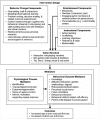A smartphone game to prevent HIV among young Kenyans: local perceptions of mechanisms of effect
- PMID: 32441759
- PMCID: PMC7243726
- DOI: 10.1093/her/cyaa011
A smartphone game to prevent HIV among young Kenyans: local perceptions of mechanisms of effect
Abstract
Electronic games delivered via smartphones have the potential to become valuable tools in HIV prevention in high-prevalence and low-resource international settings. To ground theoretical elaboration around novel mHealth interventions in contextual realities, it is important to understand the mechanisms of their effects as perceived by local populations. Such perspectives are particularly important when working cross-culturally. 'Tumaini' is an interactive narrative-based smartphone game that uses a 'choose-your-own-adventure' format. It is designed to prevent HIV among young African adolescents (aged 11-14) by increasing age and condom use at first sex. It was developed with a US-based commercial game developer and is grounded in social behavioral theory, evidence-based practice and contextually relevant scenarios. In a 2017 randomized pilot study (n = 60) in Western Kenya, 'Tumaini' showed promising effects on behavioral mediators of sexual debut. In subsequent focus group discussions, adolescent participants and their parents shared their perceptions of the game's mechanisms of effect, which included motivation to play, future orientation, decision-making, relationship to a diverse range of characters and a bridging of the virtual and real worlds. These findings align with our theoretical framework, confirm its successful translation into the intervention and will inform mediation analyses in an upcoming efficacy trial.
© The Author(s) 2020. Published by Oxford University Press. All rights reserved. For permissions, please email: journals.permissions@oup.com.
Figures
References
-
- UNAIDS, UNAIDS Data 2018. Geneva: UNAIDS, 2018.
-
- WHO, HIV and Adolescents: Guidance for HIV Testing and Counselling and Care for Adolescents Living with HIV – Recommendations for a Public Health Approach and Considerations for Policy-Makers and Managers. Geneva: WHO, 2013. - PubMed
-
- Michielsen K, Chersich MF, Luchters S. et al. Effectiveness of HIV prevention for youth in sub-Saharan Africa: systematic review and meta-analysis of randomized and nonrandomized trials. AIDS 2010; 24: 1193–202. - PubMed
-
- Poobalan AS, Pitchforth E, Imamura M. et al. Characteristics of effective interventions in improving young people’s sexual health: a review of reviews. Sex Educ 2009; 9: 319–36.
Publication types
MeSH terms
Grants and funding
LinkOut - more resources
Full Text Sources
Medical


